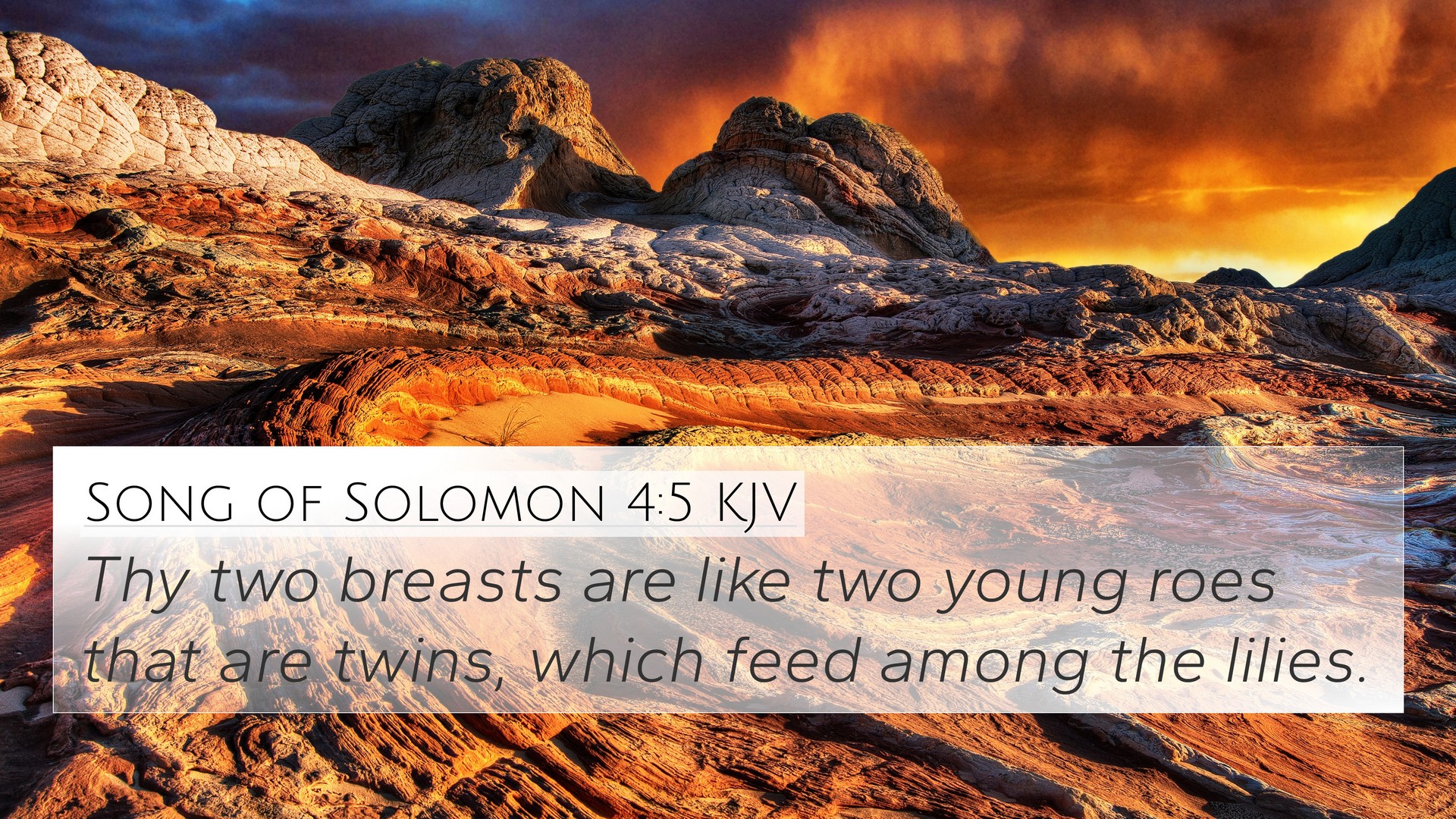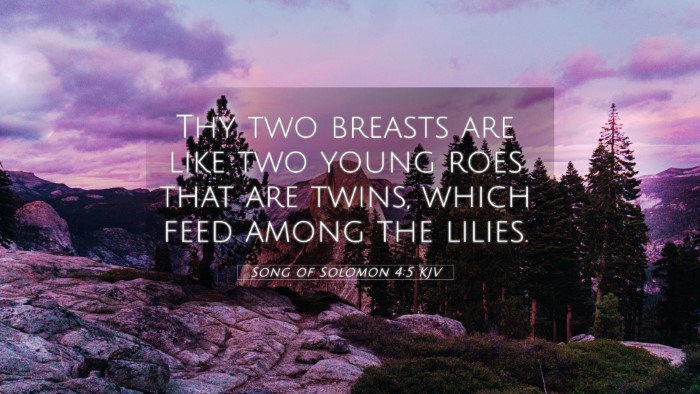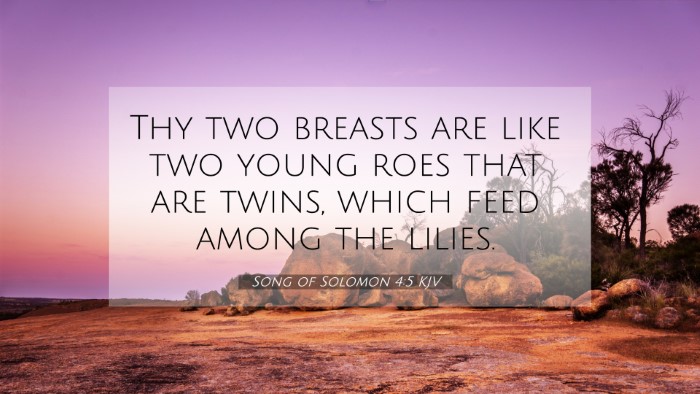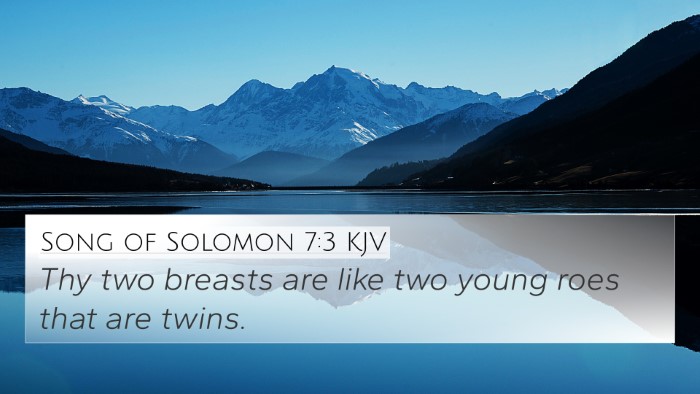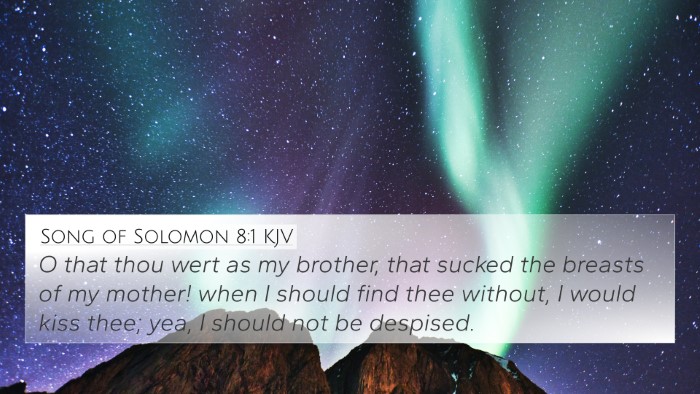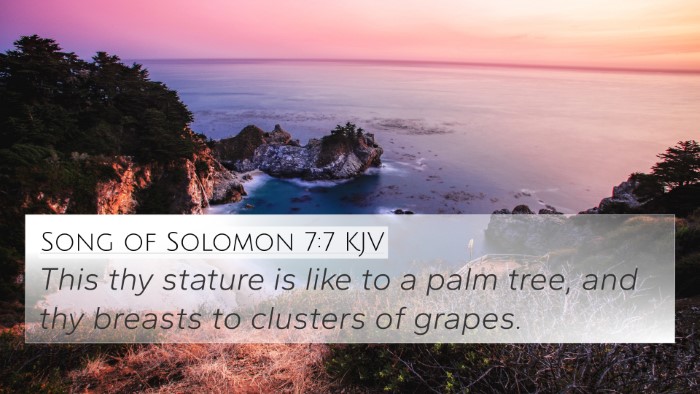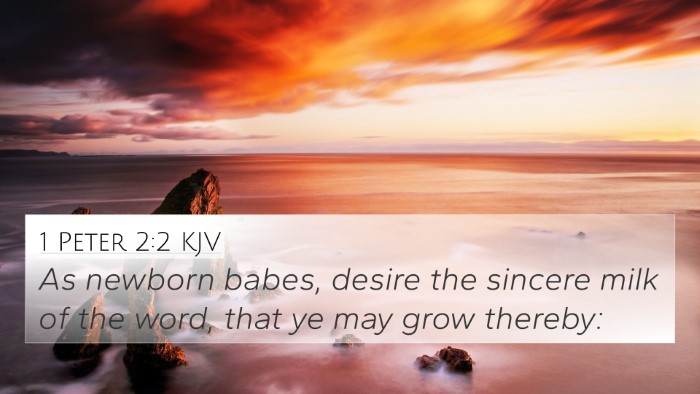Understanding Song of Solomon 4:5
Song of Solomon 4:5 states, "Thy two breasts are like two young roes that are twins, which feed among the lilies." This poetic verse from the Song of Solomon expresses a deep appreciation for beauty and the intimate relationship between lovers. Its imagery is rich, invoking the tenderness and allure of romantic love through nature's symbolism. Below is a detailed explanation and thematic analysis, using various public domain commentaries.
Verse Summary and Context
The Song of Solomon, attributed to King Solomon, is a collection of love poems celebrating physical and emotional intimacy. In Chapter 4, the voice of the bridegroom addresses his bride, extolling her virtues and beauty. This section represents a passionate expression of love characteristic of Hebrew poetry, where metaphors and natural imagery play a significant role.
Commentary Insights
-
Matthew Henry's Commentary:
Henry highlights this verse as an expression of affection, indicating the beauty of the bride's form, particularly her breasts symbolizing nourishment and closeness. He points out that in the realm of romantic love, such descriptions convey both physical attraction and a commitment to nurture one another. This corresponds to the broader theme of the Song of Solomon that encapsulates the joy and sanctity of love within the marital context.
-
Albert Barnes' Notes:
Barnes elaborates on the metaphor of "two young roes," noting that it illustrates grace and agility, reflecting the vibrancy of youth. The comparison of the breasts to these animals signifies purity, beauty, and the nurturing aspects of femininity. Barnes emphasizes that the Song serves to elevate love and sexuality to a God-honoring institution, layered with spiritual significance as well as physical.
-
Adam Clarke's Commentary:
Clarke interprets the metaphor of lilies, which often symbolize purity and beauty, suggesting that the imagery evokes not only the physical beauty of the bride but also her spiritual qualities. The "twins" reference may reflect the idea of complementarity in the relationship, portraying balance and harmony in their love.
Bible Verse Cross-References
- Proverbs 5:19 - Illustrates the joy and intimacy of marital love.
- 1 Corinthians 7:3-5 - Discusses the mutual affection and care that spouses should have for each other.
- Song of Solomon 1:15 - Reflects on the beauty and allure of the bride.
- Isaiah 58:11 - Uses imagery related to sustenance and nourishment, paralleling the themes in Song of Solomon.
- Philippians 4:8 - Condemns the importance of focusing on whatever is true, lovely, and admirable, resonating with the admiration expressed in this verse.
- Genesis 2:24 - Establishes the foundational principle of marital union, reinforcing the sanctity of love depicted in the Song.
- 1 John 4:16 - Speaks about love's divine essence, linking to the affectionate tones of the Song of Solomon.
Thematic Bible Verse Connections
This verse connects intricately with themes present throughout Scripture, particularly the sanctity of love, beauty, and marital intimacy. The representations of nature in this verse serve not only as a means of expressing physical attributes but also as symbols of the nurturing aspects of relationship and family.
Cross-Referencing Biblical Texts
Understanding Song of Solomon 4:5 through cross-references enriches our comprehension of biblical themes, enhancing our grasp of love as portrayed in both the Old and New Testaments. Engaging with these passages promotes a cohesive understanding of love's significance within the biblical narrative.
Tools for Bible Cross-Referencing
To delve deeper into the connections present in Scripture, tools such as a Bible concordance and a Bible cross-reference guide are invaluable. They allow readers to explore themes, identify connections between Bible verses, and witness how Scripture speaks to one another across different contexts.
Applying the Insights
For practical applications of the insights gained from Song of Solomon 4:5, consider using cross-referencing Bible study methods during personal or group Bible studies. This helps in understanding the nuances of biblical love, relational dynamics, and fosters a deeper understanding of God’s design for romantic relationships.
Conclusion
In summary, Song of Solomon 4:5 is a remarkable declaration of love adorned with vivid imagery that serves to elevate the theme of romantic relationship in the eyes of God. Harnessing resources for comprehensive Bible cross-reference materials and understanding the connections between various passages enhances the study of this poetic book. This allows readers to explore the rich tapestry of love, beauty, and intimacy these Scriptures encompass.
